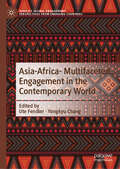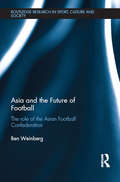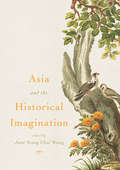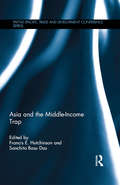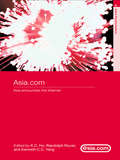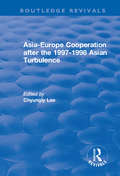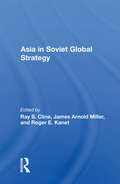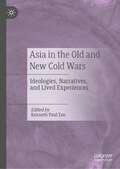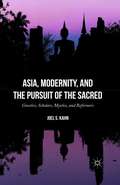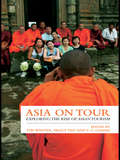- Table View
- List View
Asia-Africa- Multifaceted Engagement in the Contemporary World (Africa's Global Engagement: Perspectives from Emerging Countries)
by Yongkyu Chang Ute FendlerThis book provides an insight into the complex entanglements between African countries and India, China, and South Korea from multidisciplinary perspectives connecting approaches from cultural, anthropological, literary, and music studies and art history. The three parts present a regional focus, namely Africa-India, Africa-South Korea, and Africa-China while the single contributions speak to each other and offer complementary insights. At the same time, the chapters also link across the regional realms as they deal with similar topics, such as travelling music genres. In part I, for Pombo material culture is the starting point to investigate the connections between the islands of the Indian Ocean and India by questioning the construction of memory. It highlights various aspects of the multilayered history of connections between Africa, the islands, and India. Part II gathers contributions that are complimentary to each other and therefore contribute to the understanding of the complex entanglements in area studies. Part III (Africa-South Korea) explores the impact of African-American arts and artists on South Korea's popular culture as well as the changing perception of artists of African descent in visual popular culture. It shows the impact of Korean content in South Africa.
Asia and the Future of Football: The Role of the Asian Football Confederation (Routledge Research in Sport, Culture and Society)
by Ben WeinbergFootball is the most popular sport in the world. Globalisation and commercialisation of the game, however, have created new conflicts and challenges. This book explores the role of the Asian Football Confederation (AFC) within the rising significance of football in Asia, drawing on three key theoretical perspectives: globalisation, neo-institutionalism and governance, as well as comprehensive data from interviews and archive material. It explores the organisational structure of AFC, its decision-making processes, relations with other actors, and policies put forward. To understand the specificities AFC has faced in its 60-year history, the broader historical, political, economic, socio-cultural and geographic contexts of football in Asia are taken into account.
Asia and the Future of Football: The Role of the Asian Football Confederation (Routledge Research in Sport, Culture and Society)
by Ben WeinbergFootball is the most popular sport in the world. Globalisation and commercialisation of the game, however, have created new conflicts and challenges. This book explores the role of the Asian Football Confederation (AFC) within the rising significance of football in Asia, drawing on three key theoretical perspectives: globalisation, neo-institutionalism and governance, as well as comprehensive data from interviews and archive material. It explores the organisational structure of AFC, its decision-making processes, relations with other actors, and policies put forward. To understand the specificities AFC has faced in its 60-year history, the broader historical, political, economic, socio-cultural and geographic contexts of football in Asia are taken into account.
Asia and the Historical Imagination
by Jane Yeang WongThis collection explores the interpretation of historical fiction through fictional representations of the past in an Asian context. Emphasising the significance of region and locality, it explores local networks of political and cultural exchanges at the heart of an Asian polity. The book considers how imagined pasts converge and diverge in developed and developing nations, and examines the limitations of representation at a time when theories of world literature are shaping the way we interpret global histories and cultures. The collection calls attention to the importance of acknowledging local tensions—both within the historical and cultural make-up of a country, and within the Asian continent—in the interpretation of historical fiction. It emphasizes a broad-spectrum view that privileges the shared historical experiences of a group of countries in close proximity, and it also responds to the paradigm shift in Asian Studies. Discussing how local conditions shape and create expectations of how we read historical fiction and working with the theme of fictionality and locality, the volume provides an alternative framework for the study of world literature.
Asia and the Historical Imagination
by Jane Yeang WongThis collection explores the interpretation of historical fiction through fictional representations of the past in an Asian context. Emphasising the significance of region and locality, it explores local networks of political and cultural exchanges at the heart of an Asian polity. The book considers how imagined pasts converge and diverge in developed and developing nations, and examines the limitations of representation at a time when theories of world literature are shaping the way we interpret global histories and cultures. The collection calls attention to the importance of acknowledging local tensions—both within the historical and cultural make-up of a country, and within the Asian continent—in the interpretation of historical fiction. It emphasizes a broad-spectrum view that privileges the shared historical experiences of a group of countries in close proximity, and it also responds to the paradigm shift in Asian Studies. Discussing how local conditions shape and create expectations of how we read historical fiction and working with the theme of fictionality and locality, the volume provides an alternative framework for the study of world literature.
Asia and the Middle-Income Trap (PAFTAD (Pacific Trade and Development Conference Series))
by Francis E. Hutchinson Sanchita Basu DasThe term ‘Middle-Income Trap’ refers to countries which stagnate economically after reaching a certain level of per capita income on the basis of labour- and capital-intensive growth, and are struggling to transition towards more skill-intensive and technology-driven development. It has resonance for the increasing number of countries in Asia who have either languished in middle-income status for extended periods of time, or are worried about growth slow-downs. This book sets outs the conceptual underpinnings of the Middle-Income Trap and explores the various ways it can be defined. It also focuses on the debate surrounding the Middle-Income Trap which questions the appropriate institutional and policy settings for middle-income countries to enable them to continue past the easy phase of economic growth. The book engages with this debate by investigating the role of institutions, human capital, and trade policy in helping countries increase their income levels and by highlighting factors which enable the shift to higher and qualitatively better growth. It questions how the large emerging economies in Asia such as China, Indonesia, and India are currently grappling with the challenges of transitioning from labour-intensive to technology- and knowledge-intensive production, and discusses what can be learnt from the countries that have been able to escape the trap to attain high-income status. Providing a conceptual framework for the Middle-Income Trap, this book will be of interest to students and scholars of Asian Economics, Comparative Economics and Asian Studies.
Asia and the Middle-Income Trap (PAFTAD (Pacific Trade and Development Conference Series))
by Francis E. Hutchinson Sanchita Basu DasThe term ‘Middle-Income Trap’ refers to countries which stagnate economically after reaching a certain level of per capita income on the basis of labour- and capital-intensive growth, and are struggling to transition towards more skill-intensive and technology-driven development. It has resonance for the increasing number of countries in Asia who have either languished in middle-income status for extended periods of time, or are worried about growth slow-downs. This book sets outs the conceptual underpinnings of the Middle-Income Trap and explores the various ways it can be defined. It also focuses on the debate surrounding the Middle-Income Trap which questions the appropriate institutional and policy settings for middle-income countries to enable them to continue past the easy phase of economic growth. The book engages with this debate by investigating the role of institutions, human capital, and trade policy in helping countries increase their income levels and by highlighting factors which enable the shift to higher and qualitatively better growth. It questions how the large emerging economies in Asia such as China, Indonesia, and India are currently grappling with the challenges of transitioning from labour-intensive to technology- and knowledge-intensive production, and discusses what can be learnt from the countries that have been able to escape the trap to attain high-income status. Providing a conceptual framework for the Middle-Income Trap, this book will be of interest to students and scholars of Asian Economics, Comparative Economics and Asian Studies.
Asia.com: Asia Encounters the Internet (Asia's Transformations/Asia.com)
by K. C. Ho Randolph Kluver Kenneth C.C. YangThe internet is developing quicker in Asia than in any other region of the world. This book is the first comprehensive analysis of the information society in an Asian context, and the impact of these technologies in Asia. These impacts are inevitably uneven and conditioned by issues of telecommunications infrastructure, government policies, cultural and social values, and economic realities. The combination of original research, theoretical innovation and detailed case studies make this an important book for scholars and students in Asian studies, media studies, communication studies and sociology.
Asia.com: Asia Encounters the Internet (Asia's Transformations/Asia.com)
by K. C. Ho Randy Kluver C. C. YangThe internet is developing quicker in Asia than in any other region of the world. This book is the first comprehensive analysis of the information society in an Asian context, and the impact of these technologies in Asia. These impacts are inevitably uneven and conditioned by issues of telecommunications infrastructure, government policies, cultural and social values, and economic realities. The combination of original research, theoretical innovation and detailed case studies make this an important book for scholars and students in Asian studies, media studies, communication studies and sociology.
Asia, Europe, and the Emergence of Modern Science: Knowledge Crossing Boundaries
by Arun BalaThis volume brings together essays from leading thinkers to examine what role Asian traditions of knowledge played in the rise of modern science in Europe, the implications this has for the epistemology of science, and whether pre-modern Asian traditions can provide resources for advancing scientific knowledge in future.
Asia-Europe Cooperation After the 1997-1998 Asian Turbulence
by Chyungly LeeThis title was first published in 2000: When the second Asia-Europe meeting took place in London in April 1998, the EU's economic motivation of building strong links with Asia was challenged by the ongoing Asian economic crises that broke out in mid-1997. The political and social turmoil that ensued in many East Asian economies not only urges the re-examination of the East Asian economic miracle, but also reprioritizes the regional agenda and thus embarks on a new environment for Asia-Europe co-operation. The impact of this Asian turbulence on the establishment of the long-term Asia-Europe equal partnership in general and the ASEM process in particular are addressed in this book, based on the conclusions of the 1998 Asia-Europe Co-operation Forum. The aim of this book is to examine the background causes, responses, prospects and lessons of the first wave of financial crisis in Southeast Asia, and to then move on to an analysis of developments in Asia-Europe co-operative relations after the onset of the crisis. It examines the importance of continued interregional economic co-operation between ASEAN and the EU, looks at the economic impact of the 1997/98 East Asian financial crisis on the EU and analyzes the economic fabric of ASEM. In the final chapter, the book explores how the ASEM process has furthered the development of interregionalism in world affairs and discusses how the crisis has led to uncertainty for the organization's future development.
Asia-Europe Cooperation After the 1997-1998 Asian Turbulence (Routledge Revivals Ser.)
by Chyungly LeeThis title was first published in 2000: When the second Asia-Europe meeting took place in London in April 1998, the EU's economic motivation of building strong links with Asia was challenged by the ongoing Asian economic crises that broke out in mid-1997. The political and social turmoil that ensued in many East Asian economies not only urges the re-examination of the East Asian economic miracle, but also reprioritizes the regional agenda and thus embarks on a new environment for Asia-Europe co-operation. The impact of this Asian turbulence on the establishment of the long-term Asia-Europe equal partnership in general and the ASEM process in particular are addressed in this book, based on the conclusions of the 1998 Asia-Europe Co-operation Forum. The aim of this book is to examine the background causes, responses, prospects and lessons of the first wave of financial crisis in Southeast Asia, and to then move on to an analysis of developments in Asia-Europe co-operative relations after the onset of the crisis. It examines the importance of continued interregional economic co-operation between ASEAN and the EU, looks at the economic impact of the 1997/98 East Asian financial crisis on the EU and analyzes the economic fabric of ASEM. In the final chapter, the book explores how the ASEM process has furthered the development of interregionalism in world affairs and discusses how the crisis has led to uncertainty for the organization's future development.
Asia Future Shock: Business Crisis and Opportunity in the Coming Years
by M. BackmanChina is the world's biggest market for cigarettes. By 2020, 300 million Chinese will be elderly. By 2010, China will have 7 of the world's biggest shopping malls. This book is an invaluable asset for corporate planners and strategists, futurologists, and anyone developing business in Asia as Backman provides an essential map for Asia's future.
Asia In Soviet Global Strategy
by Ray S. ClineThis book, the final report of the Soviet Global Strategy Project, describes the USSR's basic approach to the many states in Asia and the Pacific Basin, including nations stretching from Japan to Australia.
Asia In Soviet Global Strategy
by Ray S. Cline James Arnold Miller Roger E. KanetThis book, the final report of the Soviet Global Strategy Project, describes the USSR's basic approach to the many states in Asia and the Pacific Basin, including nations stretching from Japan to Australia.
Asia in the Old and New Cold Wars: Ideologies, Narratives, and Lived Experiences
by Kenneth Paul TanThis is a collection of essays marking the 30th anniversary of the historic Cold War’s formal conclusion in 1991. It enriches Cold War studies—a field dominated by Political Science, International Relations, and History—with insights from Sociology, Anthropology, Cultural Studies, and Film and Media Studies. Through critical analysis of newspaper and magazine articles, films, novels, art exhibits, museums, and other commemorative sites that engage with the themes of conflict, violence, trauma, displacement, marginalization, ecology, and identity, the book provides rich and diverse perspectives on the complex relationship between the historic Cold War and its legacies on the one hand and, on the other, their impact on Asia, its plural histories and peoples, and their shifting identities, ideological beliefs, and lived experiences. Today, we often speak of an ‘Asian century’ and witness intensifying concerns over ‘new cold wars’ or ‘Cold War 2.0’. A United States in decline and a China on the rise create conditions for a new superpower rivalry, with a trade war already being fought between the two competitors. Russia continues to flex its geopolitical muscles, launching a full-scale invasion of neighbouring Ukraine in 2022, as its strongman leadership yearns nostalgically for the good old days of the USSR. As grand narratives and strategies of the Cold War jostle to make sense of high-level geopolitical events, this book descends to the level of lived experience, zooming in on ordinary and marginalized peoples, whose lives and livelihoods have been affected over the decades by the Cold War and its legacies.
Asia in the Undergraduate Curriculum: A Case for Asian Studies in Liberal Arts Education
by Van Jay Symons Suzanne Wilson BarnettThe contributors place the development of Asian studies programs in small colleges in historical context, make a compelling case for the inclusion of Asian studies in the liberal arts curriculum, and consider the challenges faced in developing and sustaining Asian studies programs and ways of meeting such challenges now and in the future.
Asia in the Undergraduate Curriculum: A Case for Asian Studies in Liberal Arts Education
by Van Jay Symons Suzanne Wilson BarnettThe contributors place the development of Asian studies programs in small colleges in historical context, make a compelling case for the inclusion of Asian studies in the liberal arts curriculum, and consider the challenges faced in developing and sustaining Asian studies programs and ways of meeting such challenges now and in the future.
Asia in Western and World History: A Guide for Teaching
by Ainslie T. Embree Carol GluckA guide aimed at introducing students to the history of Asia in conjunction with Western and world history.
Asia in Western and World History: A Guide for Teaching (Columbia Project On Asia In The Core Curriculum Ser.)
by Ainslie T. Embree Carol GluckA guide aimed at introducing students to the history of Asia in conjunction with Western and world history.
Asia Inside Out: Connected Places
by Eric TagliacozzoAsia Inside Out reveals the dynamic forces that have linked regions of the world’s largest continent. Connected Places, the second of three volumes, highlights the flows of goods, ideas, and people across natural and political boundaries and illustrates the confluence of factors in the historical construction of place and space.
Asia Inside Out: Connected Places
by Eric TagliacozzoAsia Inside Out reveals the dynamic forces that have linked regions of the world’s largest continent. Connected Places, the second of three volumes, highlights the flows of goods, ideas, and people across natural and political boundaries and illustrates the confluence of factors in the historical construction of place and space.
Asia Inside Out: Itinerant People
by Eric Tagliacozzo Helen F. Siu Peter C. PerdueIn the final volume of Asia Inside Out, a stellar interdisciplinary team of scholars shows the ways that itinerant groups criss-crossing the continent have transformed their culture and surroundings. Going beyond time and place, which animated the first two books, this third one looks at human beings on the move.
Asia, Modernity, and the Pursuit of the Sacred: Gnostics, Scholars, Mystics, and Reformers
by Joel S. KahnAsia, Modernity, and the Pursuit of the Sacred examines a large number of Europeans who, disillusioned with western culture and religion after World War I, and anticipating the spiritual seekers of the counterculture, turned to the religious traditions of Asia for inspiration.
Asia on Tour: Exploring the rise of Asian tourism
by Tim Winter Peggy Teo T. C. ChangWith the vast majority of academic theory on tourism based onWestern tourists, Asia on Tour illustrates why the rapid growth of travel for leisure and recreation in Asia demands a reappraisal of how tourism is analyzed and understood. Examining domestic and intra-regional tourism, the book reveals how improvements in infrastructures, ever increa
